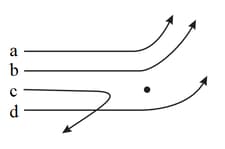Atomic Model
Atomic Model: Overview
This topic covers concepts, such as, Atomic Model, The Thomson Model, Calculation of Specific Charge by Thomson's Method & Explanation of Emission of Electromagnetic Radiations from Atom Using Thomson's Model of Atom etc.
Important Questions on Atomic Model
In Rutherford scattering experiment, the correct angle of scattering of α− particles for impact parameter equal to zero is
In Rutherford's experiment, the alpha particles that come closer to the nuclei are
Out of the following statements regarding Rutherford's model, which of the following is/are correct?
a. Most of the space inside an atom is empty.
b. The electrons revolve around the nucleus under the influence of coulomb force acting on them.
c. Most part of the mass of the atom and its positive charge are concentrated at its centre.
d. The stability of atom was established by the model.
Velocity of electron orbiting around nucleus of hydrogen atom is proportional to radius (r)
Radius of the smallest orbit of hydrogen atom is
The total energy of an electron in the first excited state of the hydrogen atom is about . The potential energy of the electron in this state is (in )
The gravitational force between a -atom and another particle of mass will be given by Newton's law , where is in metre and
Geiger-Marsden experiment is related with the size of the-
A proton of mass and charge is projected from a very large distance towards an -particle with velocity Initially -particle is at rest, but it is free to move. If gravity is neglected, then the minimum separation along the straight line of their motion will be
A beam of fast moving alpha particles were directed towards a thin film of Gold. The parts and of the transmitted and reflected beams corresponding to the incident parts and of the beam are shown in the adjoing diagram. The number of alpha particles in

The number of scattered -particles detected versus scattering angle graph for -particle scattering experiment (Rutherford) is best represented by
The angular momentum of an electron in hydrogen atom is Here is the Plank's constant. The kinetic energy of this electron is
The diagram shows the path of four particles of the same energy being scattered by the nucleus of an atom simultaneously. Which of these are/is not physically possible?

The electron in a -atom makes transition where and are principal quantum numbers of two states. Assume the Bohr model to be valid. The time period of the electron in the initial state is eight times the final state. Then, the possible value of and are
An particle with kinetic energy is heading towards a fixed nucleus of atomic number The distance of its closest approach is directly proportional to
In Rutherford's experiment, an -particle of mass and charge moves at high speed , along the -axis. It is initially near , and it ends up near The gold nucleus having charge is fixed at the point . As the -particle passes the stationary nucleus, its -component of velocity does not change appreciably, but it acquires a small velocity in the -direction. The angle through which the -particle is deflected is,
